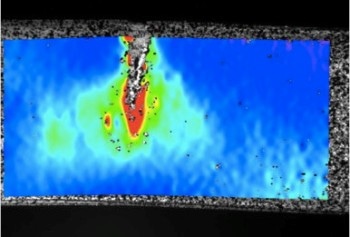May 25 2016
A team of Penn State researchers claim that the ring teeth of a certain type of squid species could pave the way for self-healing polymers, meticulously built for stretchability and specific toughness. This polymer may have potential for use in the cosmetics, textiles, and medicine industries.
 Digital Image Correlation shows fracture of a synthethic protein sample. (Image: Reginald Hamilton / Penn State)
Digital Image Correlation shows fracture of a synthethic protein sample. (Image: Reginald Hamilton / Penn State)
"We looked at what is common among squid teeth proteins for all species of squid we studied," said Abdon Pena-Francesch, graduate student in engineering science and mechanics. "We observed which properties changed dramatically for each set of proteins."
Four squid species - Hawaiian bobtail squid, European squid, long-finned squid and Japanese flying squid - from various regions were selected for the study by Huihun Jung, a Ph.D. student in Melik Demirel's lab group.
It was a mystery why nature uses more than one protein to make the ring teeth in the suckers. Why did we need so many? It turns out that each has different mechanical properties.
Melik Demirel, Professor, Penn State University
The ring teeth contain proteins, which are semicrystalline, a mixture of amorphous and crystalline pieces. The natural proteins also possess diverse repeats, amino acid strings that replicate themselves once or several times. These repeats modify the protein’s length. But the function of these repeats is yet to be known.
After sequencing the different squid proteins, the researchers put together different kinds of synthetic ring teeth proteins with a diverse numbers of repeats. The team published the results of the study in the online issue of the Proceedings of the National Academy of Sciences.
Programmable protein-based materials
Short repetitive protein vs. long repetitive protein (Melik Demirel / Penn State)
There has been a lot of work done making structures to mimic proteins. People have looked at the structure of proteins in silk, the elastin in skin, the resilin in insect wings and collagen in a large set of structures, but no one has looked at squid in this way. Squid mimics have not been done before.
Melik Demirel, Professor, Penn State University
The Demirel group partnered with Benjamin Allen, research associate in biochemistry and molecular biology and the Huck Institutes, and created various lengths of amino acid strings known as polypeptides. When these are used in the synthetic material, extensibility and toughness are enhanced as the molecular weight increases. When the polypeptide chain is longer, the molecular weight is greater. They also discovered that the balance between elasticity and plasticity stayed unaffected.
"We can control which amino acids we use, so we can control the molecular weights," said Pena-Francesch. "We can design each segment and see what fundamentals of mechanics apply."
The researchers suggest that "the repetitions in native squid proteins could have a genetic advantage for increased toughness and flexibility."
We found that the shortest polypeptide chains were brittle. As they get longer, they are stretchy.
Melik Demirel, Professor, Penn State University
The material’s structural properties can be easily programmed. Highly elastic materials, such as the proteins’ amorphous portion, soak up energy and can be applied in objects like automobile bumpers, while the proteins’ crystalline portion behave like a spring and resembles the material in the dashboard of a car. An accurate balance between the two could lead to desired materials features.
Their building blocks - the synthetic amino acids - are created by bacteria, making it unnecessary to harvest live squid. Furthermore, the synthetic materials have the self-healing feature, enabling small breaks and cracks to be repaired.
Demirel with his team observed that the synthetic version of the proteins of the squid ring teeth can be processed to form an array of 3D shapes including lithographic patterns, ribbons, and nanotubes with a wide range of probable applications.
The study was also assisted by Reginald F. Hamilton, assistant professor in engineering science and mechanics and the Materials Research Institute; Alham Saadat and Aswathy Sebastian, technicians in biochemistry and molecular biology and the Huck Institutes; Istvan Albert, professor of bioinformatics and member of the Huck Institutes; and Dong Hwan Kim, undergraduate in biology.
The research team has filed a preliminary patent application on this study.